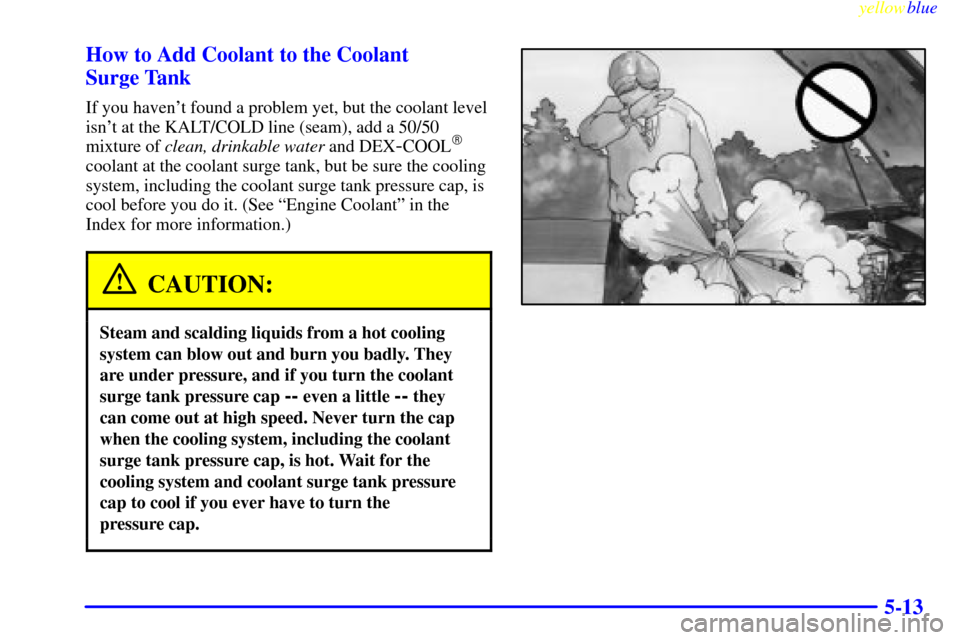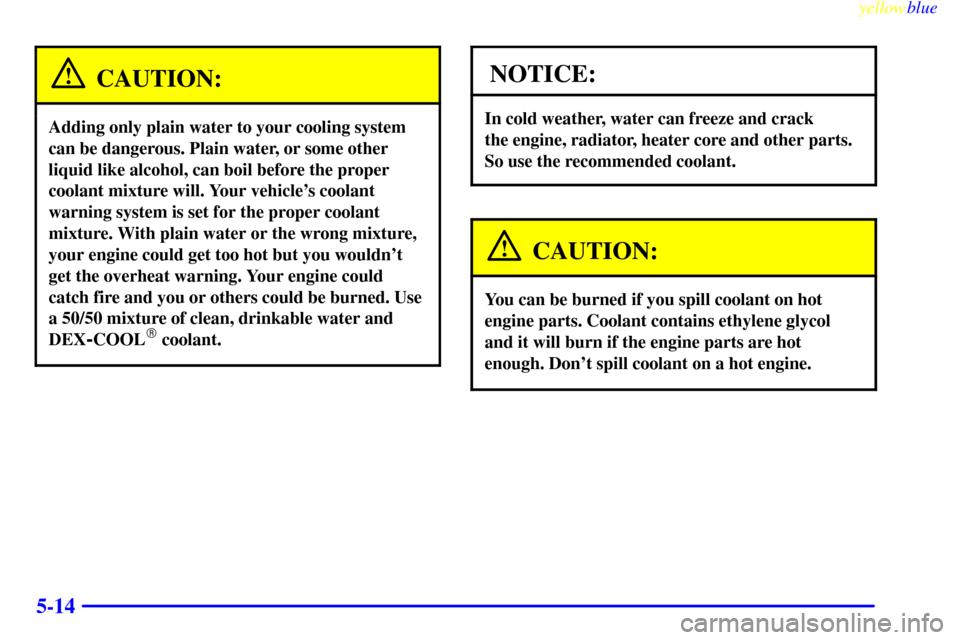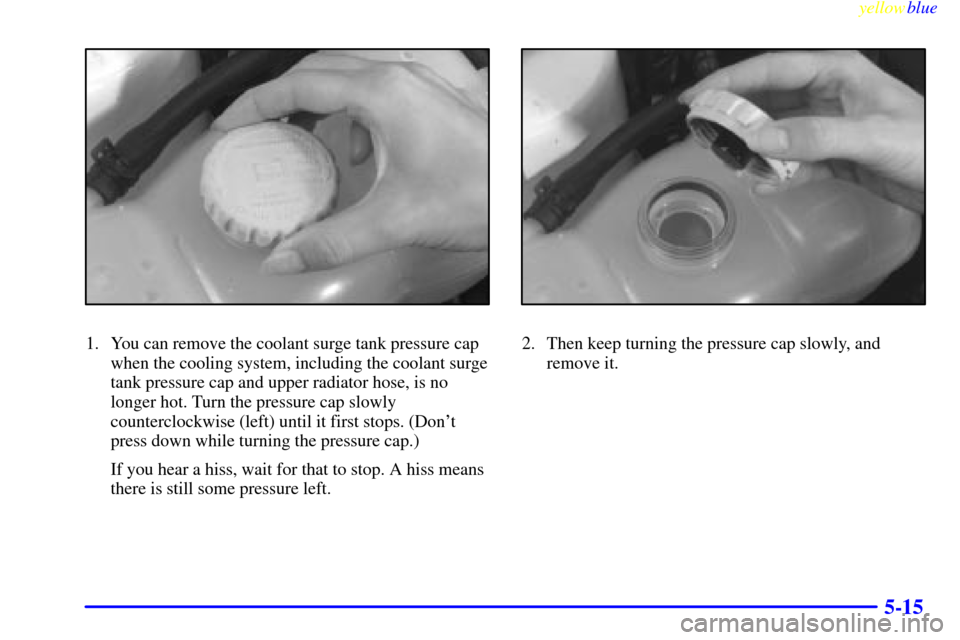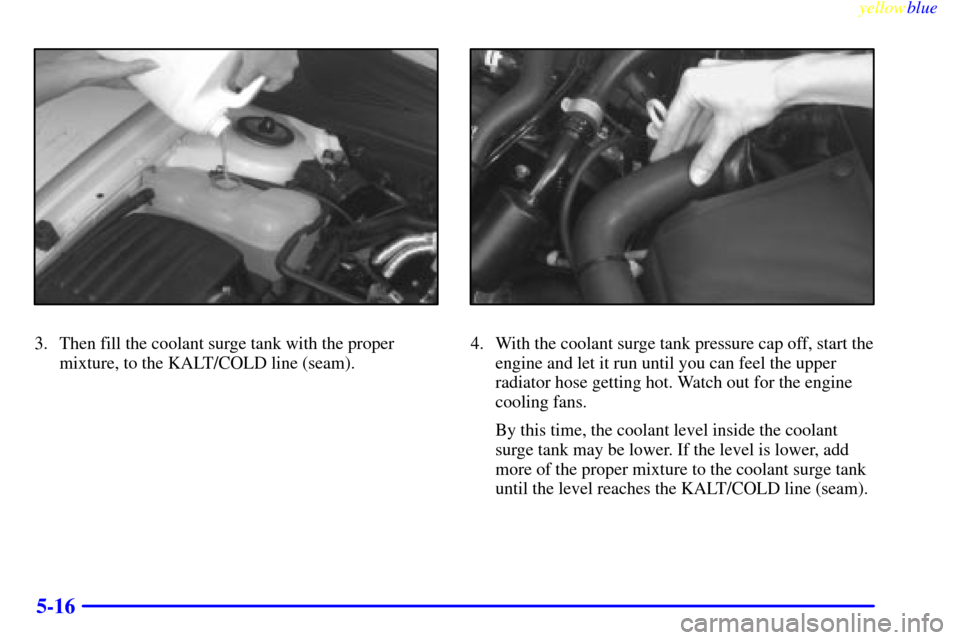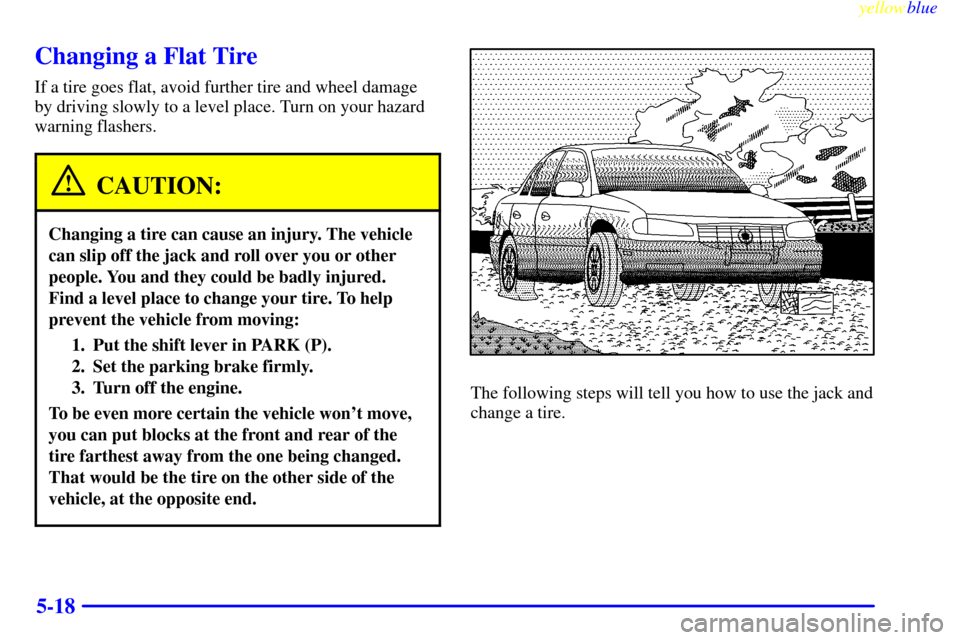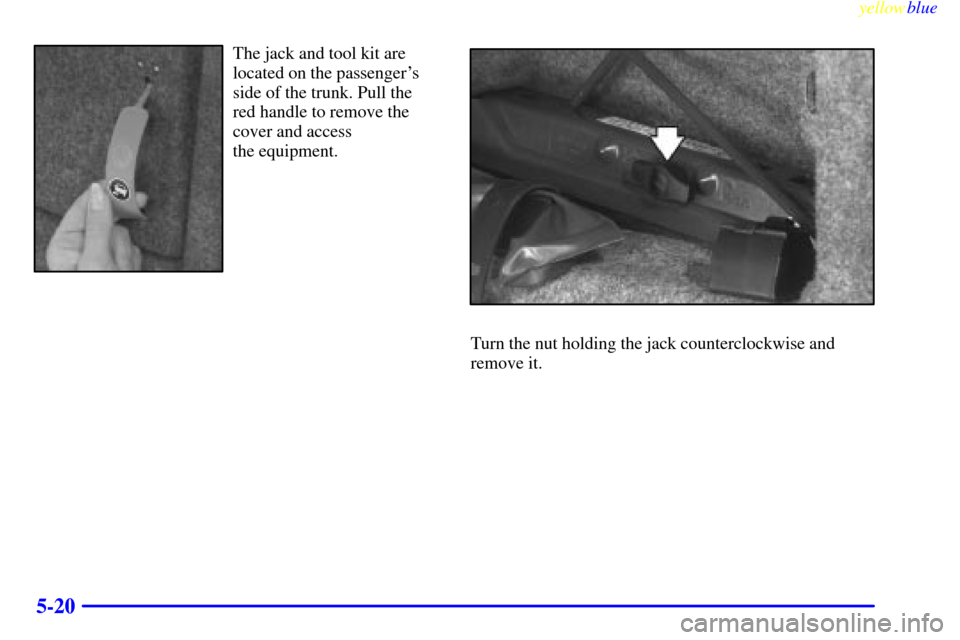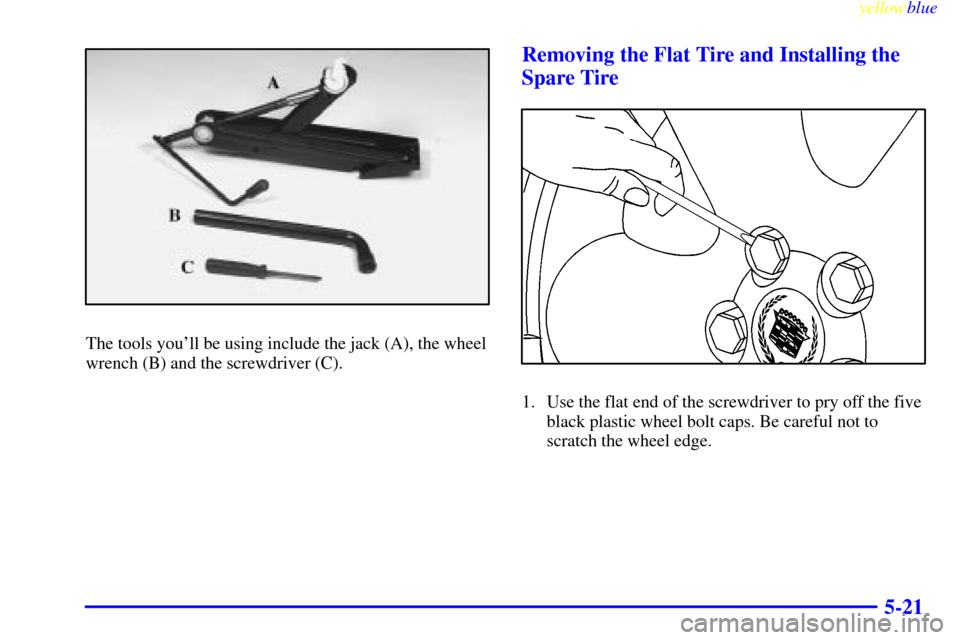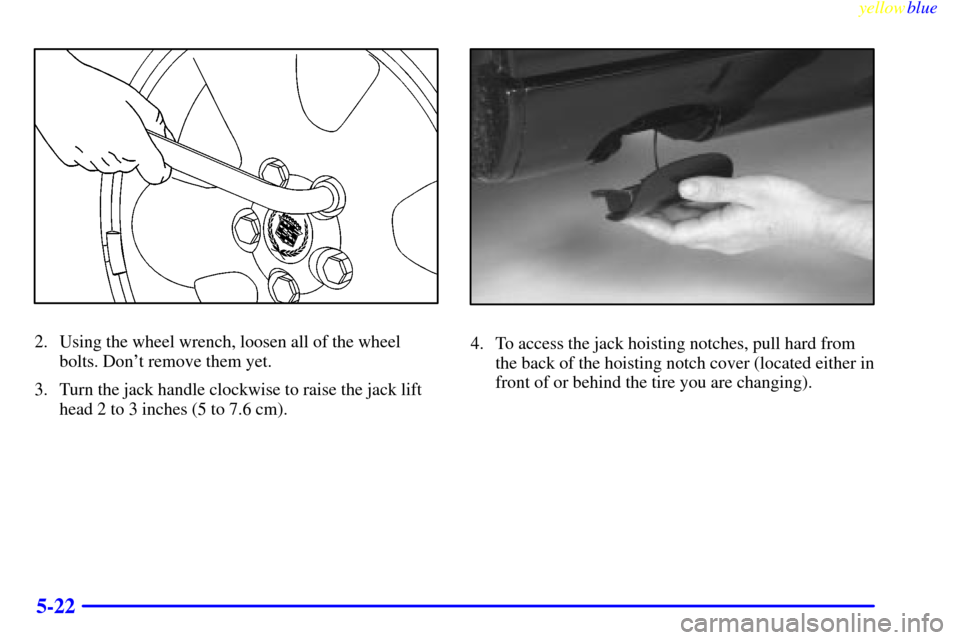CADILLAC CATERA 1999 1.G Owners Manual
CATERA 1999 1.G
CADILLAC
CADILLAC
https://www.carmanualsonline.info/img/23/7856/w960_7856-0.png
CADILLAC CATERA 1999 1.G Owners Manual
Trending: oil viscosity, service schedule, key, sunroof, seat memory, ESP, refrigerant type
Page 221 of 328
yellowblue
5-13 How to Add Coolant to the Coolant
Surge Tank
If you haven't found a problem yet, but the coolant level
isn't at the KALT/COLD line (seam), add a 50/50
mixture of clean, drinkable water and DEX
-COOL�
coolant at the coolant surge tank, but be sure the cooling
system, including the coolant surge tank pressure cap, is
cool before you do it. (See ªEngine Coolantº in the
Index for more information.)
CAUTION:
Steam and scalding liquids from a hot cooling
system can blow out and burn you badly. They
are under pressure, and if you turn the coolant
surge tank pressure cap
-- even a little -- they
can come out at high speed. Never turn the cap
when the cooling system, including the coolant
surge tank pressure cap, is hot. Wait for the
cooling system and coolant surge tank pressure
cap to cool if you ever have to turn the
pressure cap.
Page 222 of 328
yellowblue
5-14
CAUTION:
Adding only plain water to your cooling system
can be dangerous. Plain water, or some other
liquid like alcohol, can boil before the proper
coolant mixture will. Your vehicle's coolant
warning system is set for the proper coolant
mixture. With plain water or the wrong mixture,
your engine could get too hot but you wouldn't
get the overheat warning. Your engine could
catch fire and you or others could be burned. Use
a 50/50 mixture of clean, drinkable water and
DEX
-COOL� coolant.
NOTICE:
In cold weather, water can freeze and crack
the engine, radiator, heater core and other parts.
So use the recommended coolant.
CAUTION:
You can be burned if you spill coolant on hot
engine parts. Coolant contains ethylene glycol
and it will burn if the engine parts are hot
enough. Don't spill coolant on a hot engine.
Page 223 of 328
yellowblue
5-15
1. You can remove the coolant surge tank pressure cap
when the cooling system, including the coolant surge
tank pressure cap and upper radiator hose, is no
longer hot. Turn the pressure cap slowly
counterclockwise (left) until it first stops. (Don't
press down while turning the pressure cap.)
If you hear a hiss, wait for that to stop. A hiss means
there is still some pressure left.2. Then keep turning the pressure cap slowly, and
remove it.
Page 224 of 328
yellowblue
5-16
3. Then fill the coolant surge tank with the proper
mixture, to the KALT/COLD line (seam).4. With the coolant surge tank pressure cap off, start the
engine and let it run until you can feel the upper
radiator hose getting hot. Watch out for the engine
cooling fans.
By this time, the coolant level inside the coolant
surge tank may be lower. If the level is lower, add
more of the proper mixture to the coolant surge tank
until the level reaches the KALT/COLD line (seam).
Page 225 of 328
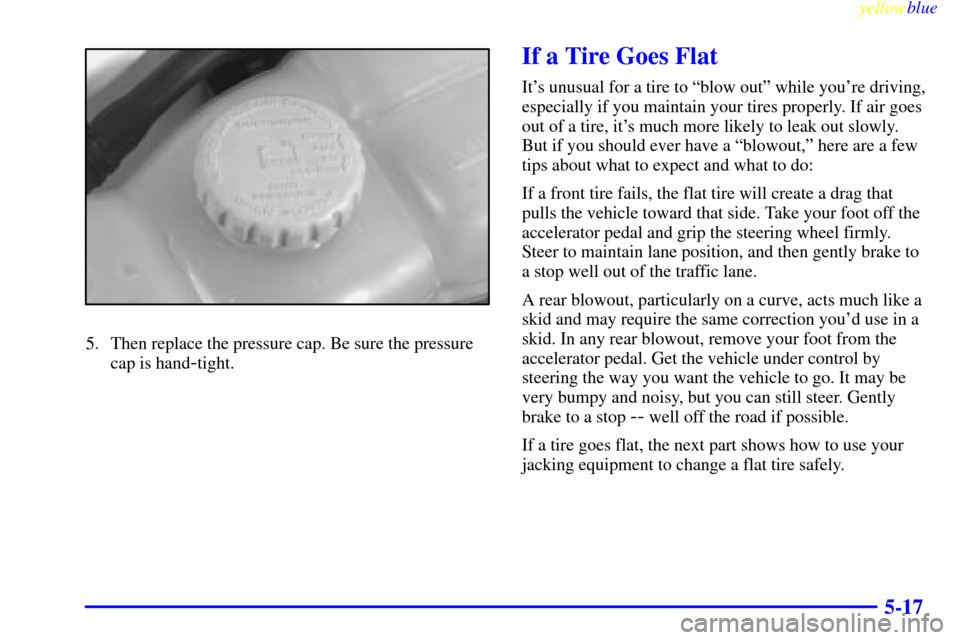
yellowblue
5-17
5. Then replace the pressure cap. Be sure the pressure
cap is hand
-tight.
If a Tire Goes Flat
It's unusual for a tire to ªblow outº while you're driving,
especially if you maintain your tires properly. If air goes
out of a tire, it's much more likely to leak out slowly.
But if you should ever have a ªblowout,º here are a few
tips about what to expect and what to do:
If a front tire fails, the flat tire will create a drag that
pulls the vehicle toward that side. Take your foot off the
accelerator pedal and grip the steering wheel firmly.
Steer to maintain lane position, and then gently brake to
a stop well out of the traffic lane.
A rear blowout, particularly on a curve, acts much like a
skid and may require the same correction you'd use in a
skid. In any rear blowout, remove your foot from the
accelerator pedal. Get the vehicle under control by
steering the way you want the vehicle to go. It may be
very bumpy and noisy, but you can still steer. Gently
brake to a stop
-- well off the road if possible.
If a tire goes flat, the next part shows how to use your
jacking equipment to change a flat tire safely.
Page 226 of 328
yellowblue
5-18
Changing a Flat Tire
If a tire goes flat, avoid further tire and wheel damage
by driving slowly to a level place. Turn on your hazard
warning flashers.
CAUTION:
Changing a tire can cause an injury. The vehicle
can slip off the jack and roll over you or other
people. You and they could be badly injured.
Find a level place to change your tire. To help
prevent the vehicle from moving:
1. Put the shift lever in PARK (P).
2. Set the parking brake firmly.
3. Turn off the engine.
To be even more certain the vehicle won't move,
you can put blocks at the front and rear of the
tire farthest away from the one being changed.
That would be the tire on the other side of the
vehicle, at the opposite end.
The following steps will tell you how to use the jack and
change a tire.
Page 227 of 328
yellowblue
5-19 Removing the Spare Tire and Tools
The equipment you'll need is in the trunk. On the
driver's side of the trunk is the spare tire. Pull the
fasteners on the spare tire cover to access the tire.
Unbuckle the tire and lift it up to remove it from
the trunk.
Page 228 of 328
yellowblue
5-20
The jack and tool kit are
located on the passenger's
side of the trunk. Pull the
red handle to remove the
cover and access
the equipment.
Turn the nut holding the jack counterclockwise and
remove it.
Page 229 of 328
yellowblue
5-21
The tools you'll be using include the jack (A), the wheel
wrench (B) and the screwdriver (C).
Removing the Flat Tire and Installing the
Spare Tire
1. Use the flat end of the screwdriver to pry off the five
black plastic wheel bolt caps. Be careful not to
scratch the wheel edge.
Page 230 of 328
yellowblue
5-22
2. Using the wheel wrench, loosen all of the wheel
bolts. Don't remove them yet.
3. Turn the jack handle clockwise to raise the jack lift
head 2 to 3 inches (5 to 7.6 cm).4. To access the jack hoisting notches, pull hard from
the back of the hoisting notch cover (located either in
front of or behind the tire you are changing).
Trending: interior lights, jump start, open hood, remove seats, warning, ground clearance, belt
